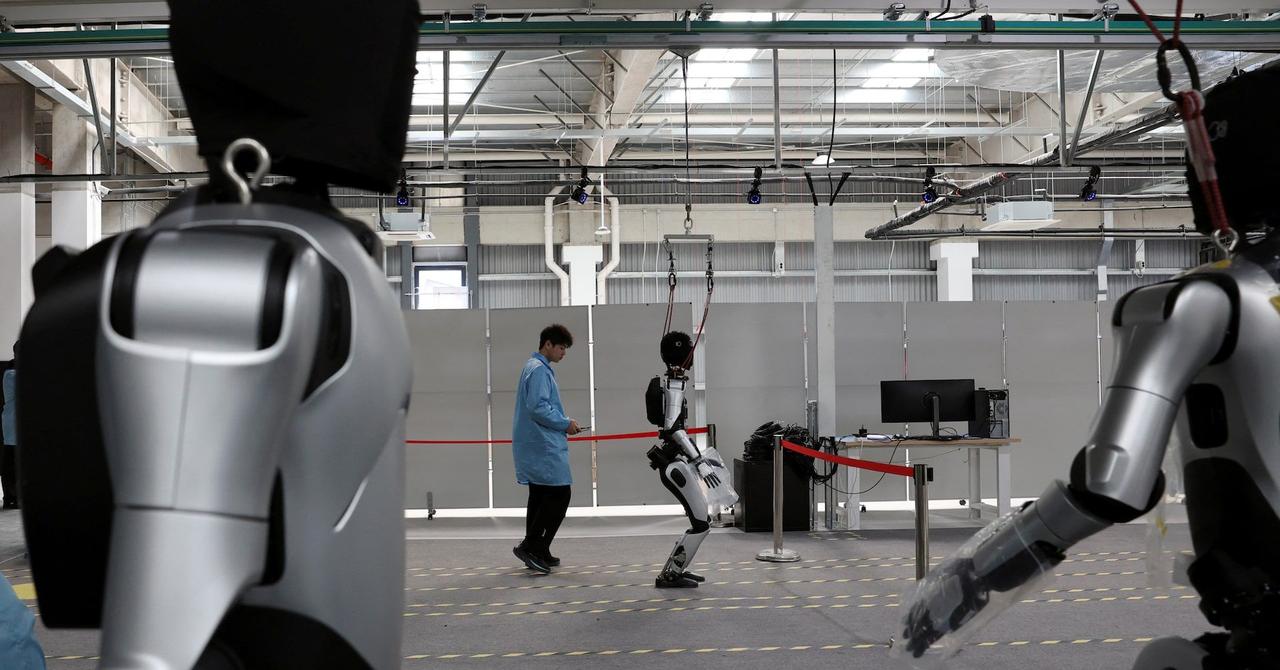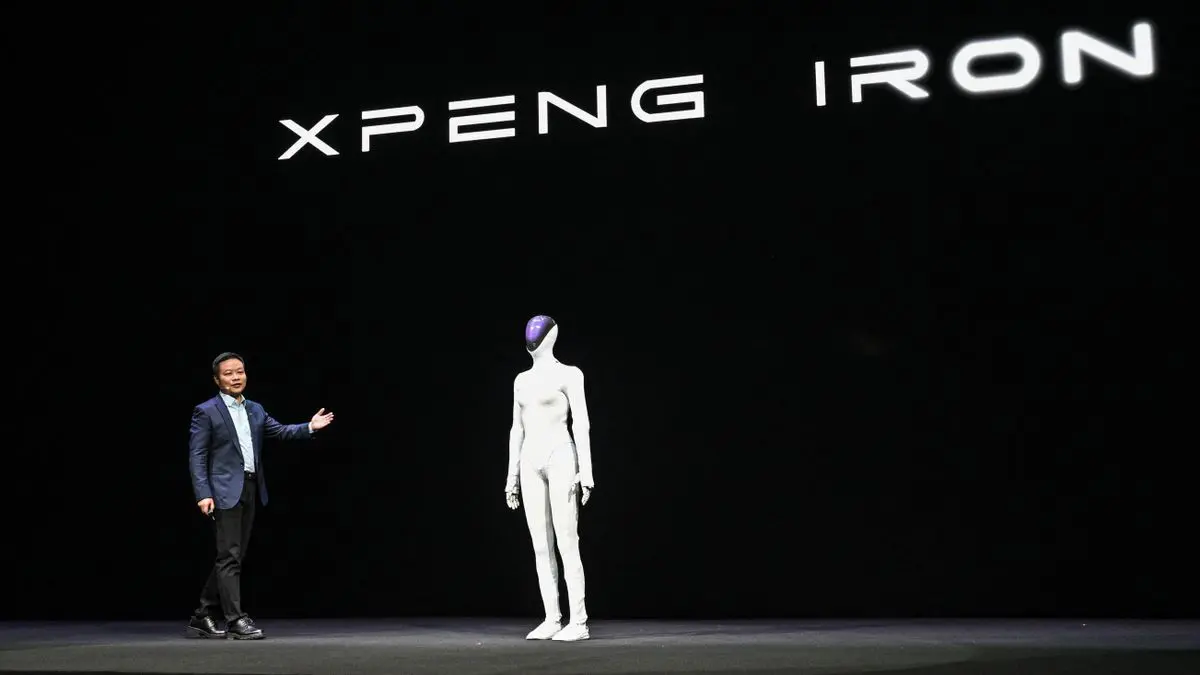China's EV Giants Pivot to Humanoid Robots: A New Frontier in Automation
2 Sources
2 Sources
[1]
China's EV Giants Are Pivoting to Humanoid Robots -- Here's Why It Matters
Robot workers built for manufacturing could also have applications elsewhere. For major Chinese electric vehicle (EV) makers, years of developing robotic and mechatronics systems for highly automated smart factories have catalyzed an emerging interest in humanoid robots. While robots built by BYD, XPeng, GAC and NIO have their roots in manufacturing and logistics, they could one day break free from the factory floor as the technology evolves. From Smart Factories to Humanoid Robots From the beginning, factory automation has been a driving force behind China's EV revolution. EV production lines in the country are almost completely free of human workers. In their place, giant mechatronic systems move chassis around like snacks in a vending machine. Meanwhile, swarms of robotic arms work in perfect synchronization to assemble even the most intricate components. For manufacturers, humanoid robots are the logical next step in the journey to ever-greater automation, replacing the last few human workers still required to produce vehicles. Among the first movers, NIO and Dongfeng Liuzhou Motor started trialing robot workers made by Shenzhen-based UBTECH last year. Several months later in November, XPeng showcased Iron, a new bot it said had already been deployed on the factory floor. Meanwhile, Guangzhou Automobile Group (GAC) announced plans to start using its GoMate robots in manufacturing facilities from 2026. Like the EV industry itself, China's emerging humanoid robots benefit from significant cost advantages compared to competitors elsewhere. For example, while Tesla's Optimus is expected to retail for $30,000-$40,000 when it goes on sale next year, a range of sub-$20,000 Chinese models are available to buy today. Furthermore, Chinese manufacturers could use humanoid robots to pull even further ahead in factory automation. This would give the country's EV industry yet another efficiency boost, driving down prices that already undercut Tesla and its Western peers. Beyond Electric Vehicles While Chinese EV companies' initial interest in robots is rooted in manufacturing automation, XPeng and GAC have both hinted at more general use cases. Just as Tesla is using its factories as an Optimus testing ground ahead of a planned wider launch, its Chinese rivals are well positioned to pivot into other markets. One of the features of the EV industry is its proximity to the electronics sector, where China's manufacturing dominance is undisputed. From spatially aware AI to the latest battery tech, many of the technologies being developed by EV companies also have applications in robotics. With mainstream adoption of humanoid robots potentially a few years away, it makes sense that an EV powerhouse like China would secure a leading role.
[2]
Inside China's electric-vehicle-to-humanoid-robot pivot
While DOGE's efforts to shutter federal agencies dominate news from Washington, the Trump administration is also making more global moves. Many of these center on China. Tariffs on goods from the country went into effect last week. There's also been a minor foreign relations furor since DeepSeek's big debut a few weeks ago. China has already displayed its dominance in electric vehicles, robotaxis, and drones, and the launch of the new model seems to add AI to the list. This caused the US president as well as some lawmakers to push for new export controls on powerful chips, and three states have now banned the use of DeepSeek on government devices. Now our intrepid China reporter, Caiwei Chen, has identified a new trend unfolding within China's tech scene: Companies that were dominant in electric vehicles are betting big on translating that success into developing humanoid robots. I spoke with her about what she found out and what it might mean for Trump's policies and the rest of the globe. James: Before we talk about robots, let's talk about DeepSeek. The frenzy for the AI model peaked a couple of weeks ago. What are you hearing from other Chinese AI companies? How are they reacting? Caiwei: I think other Chinese AI companies are scrambling to figure out why they haven't built a model as strong as DeepSeek's, despite having access to as much funding and resources. DeepSeek's success has sparked self-reflection on management styles and renewed confidence in China's engineering talent. There's also strong enthusiasm for building various applications on top of DeepSeek's models. Your story looks at electric-vehicle makers in China that are starting to work on humanoid robots, but I want to ask about a crazy stat. In China, 53% of vehicles sold are either electric or hybrid, compared with 8% in the US. What explains that? Price is a huge factor -- there are countless EV brands competing at different price points, making them both affordable and high-quality. Government incentives also play a big role. In Beijing, for example, trading in an old car for an EV gets you 10,000 RMB (about $1,500), and that subsidy was recently doubled. Plus, finding public charging and battery-swapping infrastructure is much less of a hassle than in the US. You open your story noting that China's recent New Year Gala, watched by billions of people, featured a cast of humanoid robots, dancing and twirling handkerchiefs. We've covered how sometimes humanoid videos can be misleading. What did you think? I would say I was relatively impressed -- the robots showed good agility and synchronization with the music, though their movements were simpler than human dancers'. The one trick that is supposed to impress the most is the part where they twirl the handkerchief with one finger, toss it into the air, and then catch it perfectly. This is the signature of the Yangko dance, and having performed it once as a child, I can attest to how difficult the trick is even for a human! There was some skepticism on the Chinese internet about how this was achieved and whether they used additional reinforcement like a magnet or a string to secure the handkerchief, and after watching the clip too many times, I tend to agree.
Share
Share
Copy Link
Major Chinese electric vehicle manufacturers are leveraging their expertise in factory automation to develop humanoid robots, potentially revolutionizing both manufacturing and wider applications.

China's EV Industry Shifts Gears to Humanoid Robots
China's electric vehicle (EV) giants are making a significant pivot towards humanoid robots, leveraging their expertise in factory automation to potentially revolutionize both manufacturing and wider applications. This shift comes as China continues to dominate the global EV market, with 53% of vehicles sold in the country being either electric or hybrid, compared to just 8% in the US
2
.From Smart Factories to Humanoid Workers
The journey from smart factories to humanoid robots is a natural progression for China's EV manufacturers. These companies have long relied on highly automated production lines, where giant mechatronic systems and robotic arms work in perfect synchronization to assemble vehicles
1
. This extensive experience in factory automation has paved the way for the development of more advanced robotic systems.Several major players in the Chinese EV industry are already making strides in this direction:
- NIO and Dongfeng Liuzhou Motor have begun trialing robot workers made by Shenzhen-based UBTECH
1
. - XPeng showcased its humanoid robot, Iron, which has already been deployed on factory floors
1
. - Guangzhou Automobile Group (GAC) plans to start using its GoMate robots in manufacturing facilities from 2026
1
.
Cost Advantages and Potential Impact
Chinese manufacturers are poised to gain a significant edge in the humanoid robot market due to their cost advantages. While Tesla's Optimus is expected to retail for $30,000-$40,000, Chinese models are already available for under $20,000
1
. This price difference could accelerate the adoption of humanoid robots in manufacturing, potentially giving China's EV industry an additional efficiency boost and further driving down prices.Beyond Manufacturing: Wider Applications
While the initial focus is on manufacturing automation, companies like XPeng and GAC have hinted at more general use cases for their humanoid robots
1
. The proximity of the EV industry to the electronics sector, where China's manufacturing dominance is well-established, provides these companies with a unique advantage. Many technologies developed for EVs, such as spatially aware AI and advanced battery tech, have direct applications in robotics1
.Related Stories
Cultural Impact and Public Perception
The growing interest in humanoid robots is not limited to the industrial sector. China's recent New Year Gala, watched by billions, featured a cast of humanoid robots performing intricate dances, showcasing their agility and synchronization with music
2
. While some skepticism remains about the extent of their capabilities, this public display demonstrates China's commitment to advancing robotics technology.Global Implications and Policy Considerations
As China continues to make strides in both EV and robotics technologies, there are potential implications for global trade and policy. The Trump administration has already implemented tariffs on Chinese goods and is pushing for new export controls on powerful chips
2
. The success of Chinese AI models like DeepSeek has also led to concerns in the US, with some states banning its use on government devices2
.As humanoid robots evolve from factory workers to potentially more general-purpose assistants, China's EV giants are well-positioned to lead this technological revolution. Their expertise in automation, coupled with cost advantages and a supportive domestic market, could see Chinese humanoid robots breaking free from the factory floor and into wider applications in the near future.
References
Summarized by
Navi
[2]
Related Stories
China's Robot Makers Race to Develop Humanoid Workers, Challenging Tesla
23 Aug 2024

China's AI-Powered Humanoid Robots: Transforming Manufacturing and Driving Economic Growth
13 May 2025•Technology

Xpeng's IRON Humanoid Robot Sparks Global Attention with Lifelike Movement and Controversial Design
07 Nov 2025•Technology








